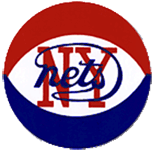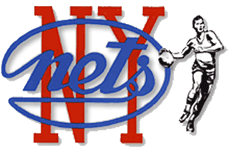New York Nets

Historical Moments:
1968/69: After a frustrating season in New Jersey, the New York area’s ABA franchise shifted to Commack a city on New York’s Long Island. Along with the move came a name change as owner Arthur Brown took seriously a suggestion to pick a name that rhymed with the baseball Mets and football Jets. However, the Nets failed to come through in what would have been the biggest move losing out on a chance to sign UCLA star Lew Alcindor who received a better offer to play for the NBA’s Milwaukee Bucks. The Nets were a team in transition as they made ten trades and went trough 23 players during an awful 17-61 season.
1969/70: The Nets got a new owner as Arthur Brown gave up on the ABA by selling his team to Roy Boe. They would also get another new home as the Nets decided to play their home games in the Island Garden in West Hempstead, which was closer to Manhattan then Commack. Also, they would land a big-name coach as they hired St. John’s legendary Coach Lou Carnesecca. However, Carnesecca had one year remaining on his contract at the New York University, so they would have to place York Larose as the interim coach for the season. With the addition of Levering Tart, who led the team with 24.2 ppg, the Nets became competitive qualifying for the playoffs with a 39-45 record. However, despite a valiant seven-game effort, the Nets playoffs end with a first-round loss to the Kentucky Colonels.
1970/71: In Lou Carnesecca’s first year as coach, the Nets made the playoffs for the second year in a row with a 40-44 record, with Rick Barry coming back from an early-season knee injury to finish second in the ABA in scoring at 29.4 ppg. However, once again, they would be knocked out after just one round lost to the Virginia Squires in the six games.
1971/72: With Rick Barry enjoying a healthy season and finishing second in scoring again with 31.5 ppg, the Nets post their first winning season at 44-40, as they change homes again in February, leaving the old Island Garden in West Hempstead for the brand new Nassau Coliseum in Uniondale. In the playoffs, the Nets would win their first series beating the Kentucky Colonels in six games. In the Eastern Finals, the Nets fell behind quickly, losing their first two games to the Virginia Squires. However, the Nets would rebound to take the next two games at the Nassau Coliseum. After losing Game 5 in Virginia, the Nets won a Game 6 shootout 146-136 to set up a decisive seventh game, which they won in Virginia 94-88. In the ABA Finals, the Nets and Indian Pacers went back and forth through the first four games before the Pacers scratched out Game 5 by one point 100-99. Needing to force a seventh game, the Nets season would end with another nail bitter 108-105.
1972/73: Before the season ended, the Nets were dealt a set back when a court-ordered that Rick Barry returned to the NBA and honored his contract with Golden State Warriors. Without Barry, the Nets struggled to finish with a 30-54 record. Despite their poor season, the Nets still made the playoffs but were beaten in five games by the Carolina Cougars. Following the season Coach, Lou Carnesecca would be fired and replaced by Kevin Loughery. However, the biggest move came via trade as the Nets acquired the budding superstar Julius Erving from the Virginia Squires.
1973/74: Julius Erving, who earned the nickname Dr. J in the press, joined a young team whose oldest starter was 25-year old Center Bill Paultz. Dr. J. would become an instant sensation, winning the ABA’s MVP while leading the league in scoring, while leading the Nets to their first Division title with a 55-29 record. In the first round of the playoffs, the Nets made quick work of Dr. J’s first team, knocking off the Virginia Squires in five games. In the Eastern Finals, the Nets would breeze through the Kentucky Colonels, sweeping them in four games. In the ABA Finals, the Nets continued to roll, winning their first three games over the Utah Stars before winning the ABA Championship before 15,934 fans at the Nassau Coliseum 111-100.
1974/75: In Julius Erving’s second season with the Nets, the team was even better finishing with a 58-26 record. However, a late four-game losing streak would cost them the Division Title. The Nets’ struggles would continue into the playoffs as they are stunned by the Spirits of St Louis in the first round losing four straight games after taking the opener by a score of 111-105.
1975/76: Doom was in sight for the ABA, as the Nets, along with the Denver Nuggets, applied for membership in the NBA. Although a court ordered the two teams to stay in the ABA, it was clear the league, which was seeing teams fold in the middle of the season, was running out of gas. Despite the distraction, Julius Erving won his third straight MVP as he led the league in scoring at 29.3 ppg. Finishing in second place in the now six-team ABA with a 55-29 record, the Nets beat the San Antonio Spurs in a hard-fought seven-game series that saw three straight games decided by two or fewer points. With the emending doom of the ABA, the Nets faced the Nuggets in the Finals. In Game 1, the Nets beat the Nuggets 120-118 before a record crowd in Denver. After losing Game 2, the series shifted to New York, where the Nets captured two close games to take a 3-1 series lead. After losing Game 5 in Denver, the Nets captured the ABA Championship with a 112-116 victory on May 13th before a sold-out Nassau Coliseum. A month following the season, the Nets, along with Denver Nuggets, San Antonio Spurs, and Indiana Pacers, were granted admission in the NBA as the ABA folded.
©MMXII Tank Productions. Stats researched by Frank Fleming, all information, and team names are property of the American Basketball Association. This site is not affiliated with the New York Nets or the ABA. This site is maintained for research purposes only. All logos used on this page were from Chris Creamer’s Sports Logos Page.
Page created on June 6, 2012. Last updated on June 7, 2012 at 12:30 am ET.



